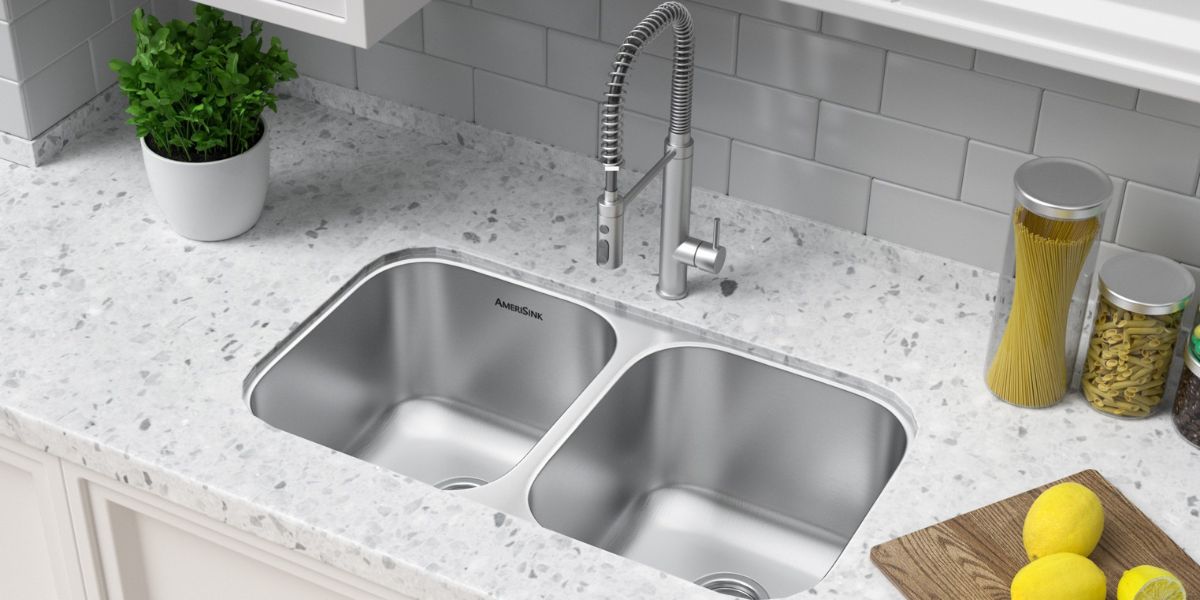Thinking of renovating your kitchen but confused about which sink to use?
No worries; we’ve got your back.
Modern kitchen designs have integrated the concepts of aesthetics and functionality to give the kitchen, which was previously the most undervalued space for decoration, its rightful value.
In light of this, a variety of kitchen sink designs are now on the market, and an undermount kitchen sink has gained popularity for both residential and commercial applications.
This article will walk you through everything you need to know, starting from what is an undermount sink, comparisons with overmount sink, types, shapes, materials, measuring techniques, pros and cons, popular brands, installation process, and a lot more.
So, without further ado, let’s get straight into the discussion.
What is an undermount kitchen sink?
An undermount sink is a style of sink that is mounted beneath a kitchen countertop. An undermount sink is thought to be the best option out of the ones that are offered for giving the countertop a seamless appearance and an easier working environment.
The lower level of the sink compared to the countertop and the lack of cracks and grooves make maintaining hygiene convenient. The spills and debris can be wiped off the countertop and dumped directly into the sink without the risk of accumulating in the joint between the sink and the countertop.
This sink is named “undermount” after its installation in relation to the kitchen countertop. The sink installation requires strong adhesive, brackets, and clips to keep the sink firmly attached to the underside of the countertop. As they need strong support, they should be installed with water-resistant solid surface countertops made of granite, marble, concrete, or other material.
Undermount sink vs Drop-in/Overmount/Top mount
The several styles of kitchen sink setups make it challenging for most homeowners to design or remodel their kitchens. The most common concern is whether to choose an undermount or overmount sink.
Do you also experience this bafflement?
Check out the following differences between an undermount and a drop-in sink to help come to a decision.
Category | Undermount | Overmount |
Placement/ Installing process | The sink is installed underneath the pre-cut countertop. | The sink is placed on the edges of the pre-cut countertop. |
Appearance | The hidden rims of the sinks make the kitchen look elegant. | The edges of the sink don’t give a sleek appearance |
Sink Cleaning | Food particles can get clogged in the seams, making keeping the sink clean bit difficult | No caulk gap for building up gunk, so it is easier to keep clean |
Countertop cleaning | Sweeping debris directly from the countertop to the sink makes countertop cleaning easy. | The rims of the sink prevent sweeping the debris from the counter directly into the sink. |
Replacement | Replacing without experts has the chance to damage the countertops | Can be replaced without damaging the countertops |
Installation Cost | Higher installation cost due to high precision fabrication | Lower installation cost as no special skill or precision needed |
Weight | Additional support required for withstanding its heavy weight | Countertop can withstand its weight without the need for additional support |
Price | More expensive | Less expensive |
Types of undermount kitchen sink
Although an undermount sink is placed beneath the countertop, there are various ways to install it. Based on their installation processes, three types of undermount kitchen sinks exist, which are:
Zero or Flush or Neutral Reveal:
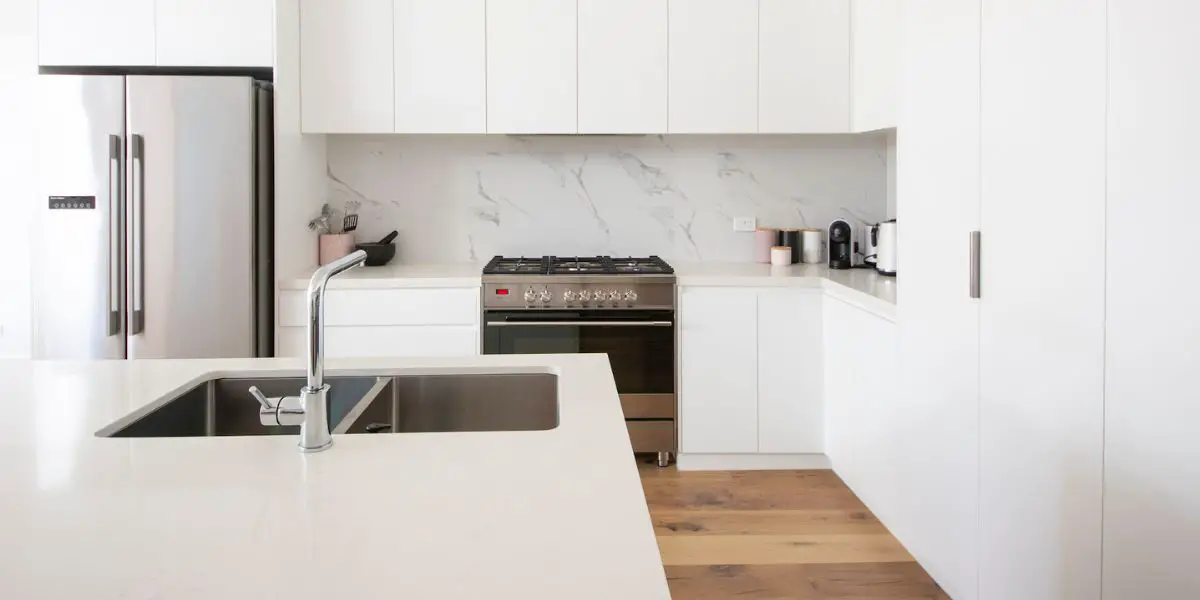
The zero reveal undermount sink is installed in such a way that the rim of the sink and the edge of the countertop remain perfectly aligned. Although the edges of the sink stay inside, the crevices and caulking remain visible.
Since the caulking will regularly come into contact with debris and water, it’s possible for waste to get stuck in a crack and foster the growth of mold.
Installing a zero reveal undermount sink is the most expensive compared to the others, as it requires precise measurements to fit the sink into the countertop perfectly.
Positive Reveal:
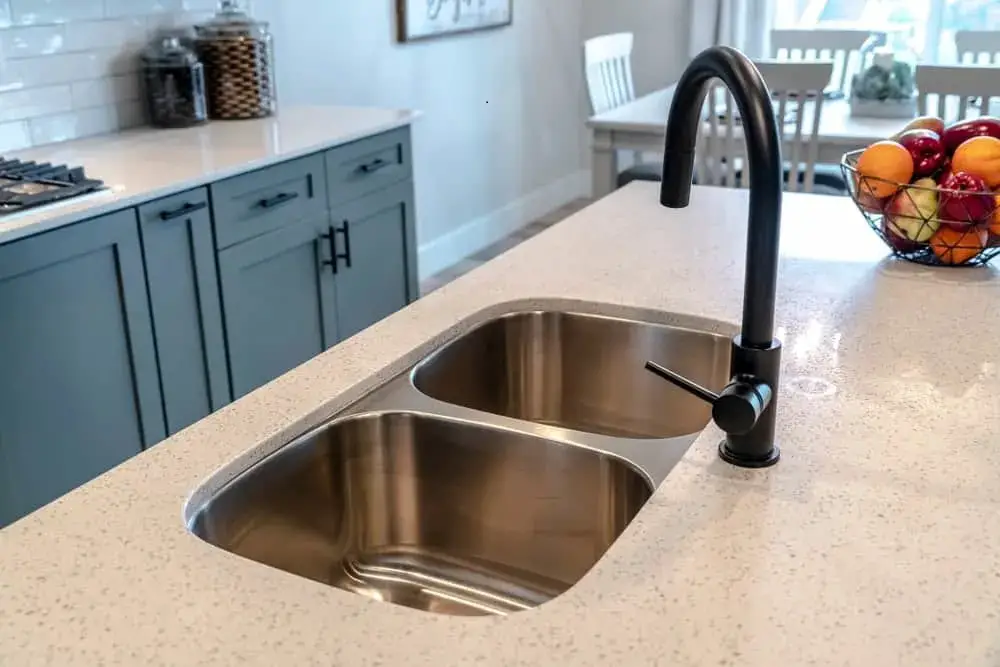
The positive reveal refers to the undermount sink, where a portion of the rim of the sink stays outside the countertop. In this installation process, the countertop is cut larger than the sink to make the rims of the sink exposed.
The exposed rims of the sink allow for a step-down from the countertop to the sink. It facilitates the sliding of food scraps and liquids into the sink without getting caught in the gap between the counter and the sink.
Most customers prefer this structurally sound undermount sink because it offers a number of advantages, such as resting kitchen accessories such as a cutting board, colander, etc., installation at a low cost, leeway in sizing in case of replacement, and more.
Negative or Overhang Reveal:
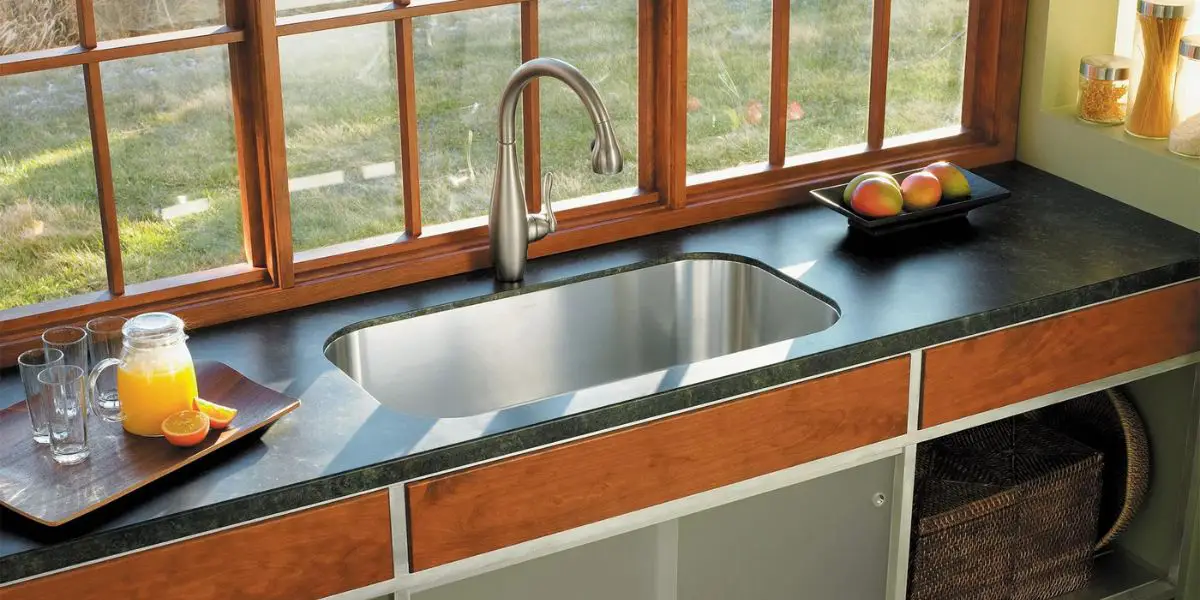
The negative reveal is the type of undermount sink, where the countertop hangs slightly over the rims of the sink. It is the best option to give the countertop a streamlined look and a bit more counter space.
The completely concealed rims and caulking under the overhanging countertop give the kitchen a sophisticated look. However, the overhanging feature has some drawbacks. For instance, debris accumulated on the overhang area of the countertop may promote the development of mold, chipping of the counter ledge, etc.
Wandering which type of sink is best for kitchen?
Well, all of them are best in a certain way. However, the one that’s best for you depends on your intention of using it.
- If you want to give your countertop and sink a uniform look, then zero or neutral reveal will be the best sink for you.
- Positive reveal sinks are the best option for your kitchen if functionality is more important to you than aesthetics. This is because you can use the extended rims for placing a chopping board or other accessories.
- If you prefer the rims of the sinks to be out of sight and more into giving the countertop a sleek appearance, then a negative reveal is your ideal choice for the sink.
Undermount kitchen sink shape
Undermount sinks come in a variety of shapes. Whether you want to give your kitchen a traditional or fancy look, an undermount kitchen sink offers the following shapes.
Rectangular:
The rectangular kitchen sinks have two long sides and two short sides. The unequal sides give the sink greater space for washing or soaking large pans. Although it gives the sink a simple appearance, it helps to maximize the sink’s usable space.
Square:
Square sinks have all equal sides. They are available for both single and double-sink bowls. Despite having a similar working experience to rectangular sinks, they have less usable space.
Specialty:
The specialty sinks give a kitchen a fancy look. The sinks may have irregular shapes, such as unequal sides, curves, or other designs. This type of sink is not appropriate for handwashing large pots and pans because they require spacious sinks, which may be reduced because of the curves.
Circular/Round:
The round or circular kitchen sink takes up more counter space. However, as pots and pans are mostly of round shapes, stacking dishes is convenient. However, if the sink is smaller in size, handwashing dishes can be a bit difficult, especially in the case of large square or rectangular crockeries.
Note that, if the sink is smaller in size, handwashing dishes can be a bit difficult, especially in the case of large square or rectangular crockeries.
Oval:
The oval-shaped sinks are similar to the round-shaped sink. However, the elongated shape reduces the usable space of the sink, making it difficult to stack dishes for soaking or washing. So, they occupy more space without maximizing their use.
D-shaped:
The D-shaped sinks are a combination of circular and square-shaped sinks. That is, it has three circular or rounded sides and one straight side. This distinctive design gives the kitchen an elegant appearance while maximizing the sink’s usable space. Besides, the curved edges make cleaning them easier because dirt can be removed more easily from curved edges than from sharp corners.
Undermount kitchen sink materials
The kind of materials used to construct a kitchen sink has a significant impact on its durability and appearance. Besides, the maintenance process to keep the sink long-lasting varies depending on the materials. While some materials may withstand heat, others may react when exposed to acidic cleaning solutions.
Let’s look at the various material options for undermount kitchen sinks.
Stainless Steel
Stainless steel, an alloy of iron, is one of the most popular and durable materials for kitchen sinks. These sinks are the standard choice for commercial kitchens because they are easy to clean and highly resistant to rust, corrosion, stain, and heat.
The thickness of stainless steel is measured by gauge. The gauge value ranges from 15 to 24 gauge. The higher the value, the thinner the steel; the lower the value, the thicker the steel. Usually, thicker and heavier stainless steel, ranging from 16 to 18 gauge, is preferred for kitchen sinks.
Pros
- Lightweight
- Crack-proof
- Rust resistant
- Easy installation
- Reasonable price
- Can be cleaned easily
- No additional support required
Cons
- Prone to water stains
- Not scratch and dent proof
Fireclay
A fireclay sink is a porcelain enamel-coated clay sink. The timeless and classy appearance of the fireclay sink gives the kitchen a vintage vibe. The dry clay sink molds are given a porcelain enamel coating and heated at 2000 °F. This extreme heat strengthens the sink and provides it with long durability.
Considering their weight and low maintenance requirements, fireclay sinks are a great alternative to ceramic sinks. Its large, deep bowl provides ample space for cleaning dishes, pots, pans, and other utensils. However, pouring hot water down the drain or dumping a hot pan onto the sink could crack the sink. Therefore, handling it requires a bit more caution.
Pros
- Easy maintenance
- Non-porous and durable
- Doesn’t occupy a lot of room
- Resistant to acids and alkalis
Cons
- Quite expensive
- Prone to water stains and chipping
Copper
Copper sinks give a kitchen a luxurious appearance. This has some great qualities, like being environmentally friendly, strong, adaptable, and corrosion- and rust-resistant. Besides, the antimicrobial property of copper prevents the growth of molds.
Similar to stainless steel, the thickness of copper is measured in a gauge. Copper with a lower gauge is thicker and less prone to damage. That’s why 14 to 16-gauge copper is considered the best quality for sinks.
Although copper doesn’t require a lot of maintenance, it does need to be handled carefully. For example, avoid using abrasive cleaners or chemicals and acidic foods like lemon, orange, mustard, pineapple, etc
Pros
- Eco-friendly and durable
- Has antimicrobial quality
- Rust and corrosion resistant
Cons
- Expensive
- Sensitive to acid, harsh cleaning agents, and heat
Granite composite
Granite composite sinks are a mixture of around 80% granite and 20% acrylic resin. Granite composite gives the look and feel of natural stone. This durable sink is resistant to stains, scratches, heat, and chipping.
However, following a few maintenance guidelines, such as drying the sink after each use and lubricating the surface with mineral oil, can help prevent the development of a white residue that results from the buildup of lime.
Pros
- Bacteria and odor resistant
- High heat resistance upto 535 °F
- Less noisy compared to other metal
- Durable and not prone to discoloring
Cons
- Quiet heavy
- Requires additional structural support to endure the weight
Cast iron
Cast iron is an iron alloy that contains a mixture of 2-4% carbon, silicon, manganese, sulfur, and phosphorus. Even though cast iron is a durable material, adding a thick layer of enamel coating extends the lifespan of the sink and makes it last for generations.
Besides, the non-porous hard enamel coating provides a glossy finish, makes the sink stain resistant, and provides any color customization option. Nevertheless, its heavy weight requires additional support to keep it in place. Also, using wire brushes, steel wool, or heavy-duty sponges for scrubbing can chip the enamel coating, making it susceptible to scratches and rust.
Pros
- Easy cleaning
- Stain resistant
- Reasonable price
- Extremely durable
Cons
- Excessively heavy
- Mishandling can cause enamel chipping
Quartz composite
Quartz composite is a combination of acrylic resin and natural quartz in an 80/20 ratio, similar to granite composite. The non-porous layer of resin makes the surface smooth, odor- and bacteria-resistant, and easy to clean.
With a heat resistance of up to 535 °F, its durability is excessively high. Besides, because of its inherent soundproofing properties, it doesn’t make as much noise as stainless steel sinks. However, their hardness can be a disadvantage for delicate dishes, as glasses or dishes may break if dropped on them.
Pros
- Durable
- Not noisy
- Stain resistant
- Non-porous smooth finish
- Heat resistance upto 535 °F
Cons
- Heavy
- To hard for fragile dishes
NOTE:
What kitchen sink is best is a common concern for most homeowners. Stainless steel sinks are the most popular option for a kitchen sink for being lightweight, durable, and low maintenance. In contrast, materials such as fireclay, granite, quartz, or copper are generally preferred for a fancy appearance.
Undermount kitchen sink bowl
Another criterion for purchasing an undermount sink for kitchen is the number of bowls. Some homeowners prefer a deep single bowl, while some prefer multiple bowls.
Let’s check out the different number of sink bowls and their features so you can differentiate between their functions and choose the right sink bowl for your kitchen,
Single bowl
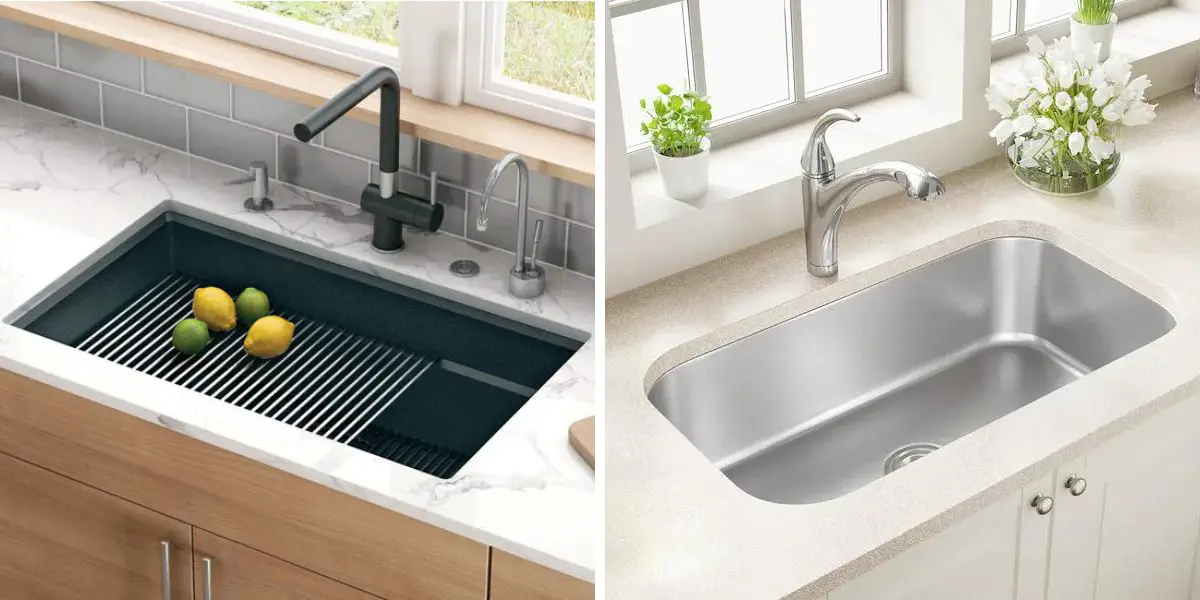
A single-bowl undermount kitchen sink has only one deep basin installed under the countertop. This type of sink is suitable for stacking and washing large utensils. They are cheaper and easier to install compared to other bowl categories. Besides, they are available in a number of sizes, depths, radius, styles, or mounting styles.
Pros
- Perfect for small counter space
- Easy and affordable installation
- Allows cleaning large pots and dishes
Cons
- Don’t allow multitasking
- Can’t separate clean and dirty dishes
Double bowl
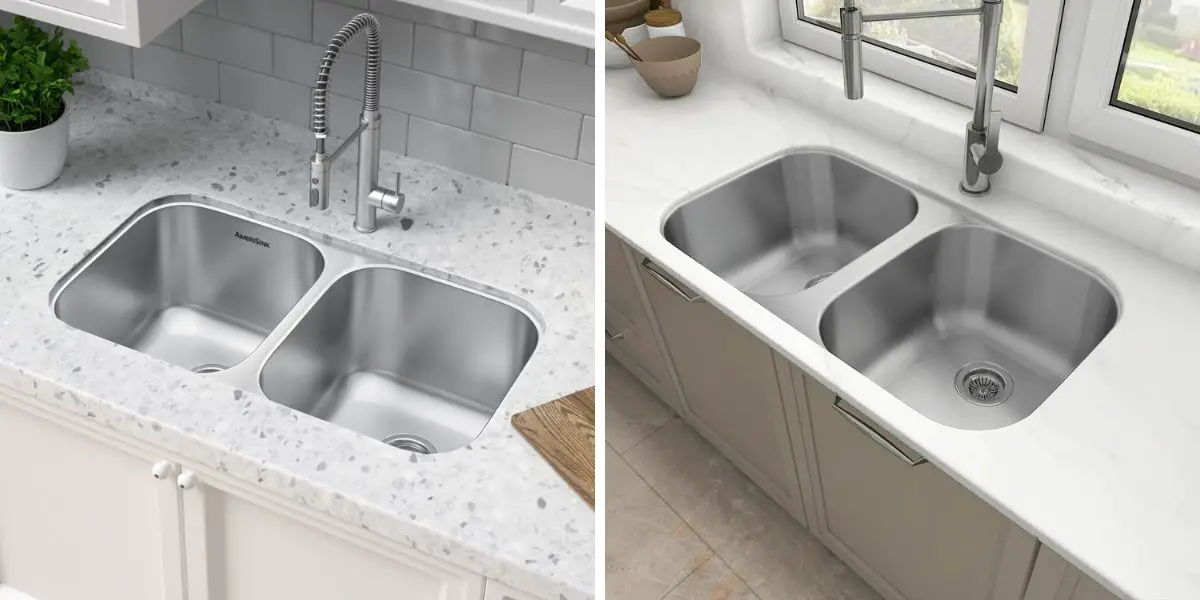
A double bowl undermount kitchen sink has two basins side-by-side with a divider in between. This style of sink is suitable for cleaning and rinsing dishes at the same time. Moreover, the bowls can be identical or different in terms of size, shape, and depth. Nowadays, double bowls are preferred by the majority of kitchen sinks.
Pros
- Allows multitasking
- Individual washing and drying area
- Bigger, smaller, fragile dishes can be washed separately
Cons
- Occupies more counter space
- Not suitable for bigger pots and dishes
Off-Set bowl
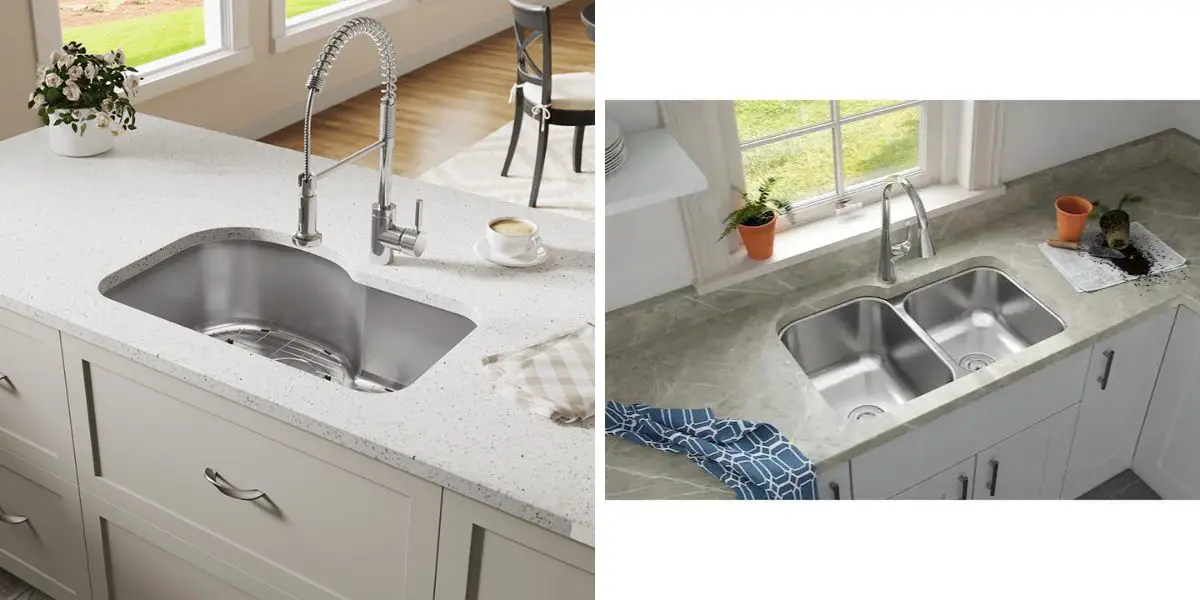
Off-set bowl is a subcategory of double bowl sinks where the bowls are of different sizes. The divider in between that separates the bowls can be both full and half the height of the sink. It offers more benefits compared to equal-sized double bowl sinks.
Pros
- Allows multitasking
- Large pots and pans can be washed
- Fragile dishes can be cleaned separately
- Allows separate space for washing and air drying dishes
Cons
- Depth is low
- Difficult to wash large pots and pans
Triple bowl
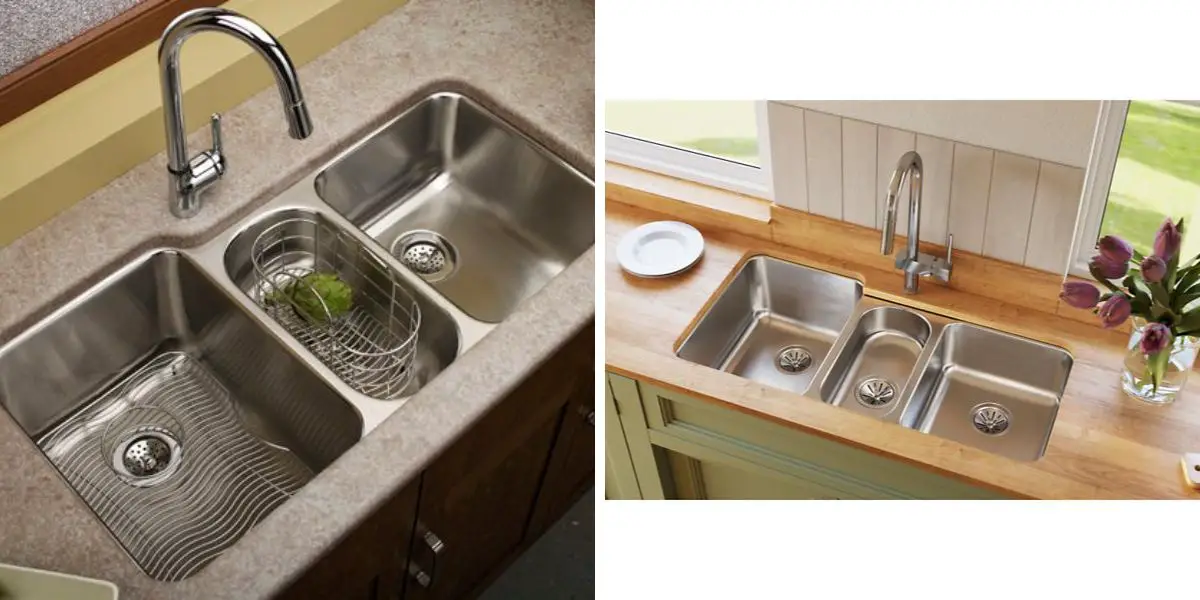
Triple bowl sinks offer more options for meal preparation. This type of sink has three different-sized bowls, usually one large, one medium, and one small. The two large and medium bowls can be used for soaking and washing dishes, while the small bowl is suitable for washing vegetables, fruits, and hands, or disposing of garbage.
Pros
- Allows multitasking
- Allows washing of both small and large pots and pans
- Separate space for washing dishes, hands, and vegetables
Cons
- Not suitable for small kitchen
- Flexible or extendable faucet is required
How to measure for an undermount kitchen sink
For an undermount kitchen sink to fit perfectly beneath the countertop inside the cabinet, precise measurements are necessary. If the measurements are not proper, it may create certain plumbing issues.
When measuring for an undermount kitchen sink, take into account the following.
Countertop & cabinet size:
The first thing to consider is the size of the countertop. Some sinks are large; some have too much depth. Depending on the size of the countertop, you have to decide whether to choose large sinks, small sinks, a single bowl, or multiple bowls.
Moreover, as the sink stays inside the walls of the cabinet, it should be at least 3 inches larger than the sink. This extra space is necessary for mounting clips. The anchors need to be drilled and secured with the clips and screws for the underside. The 3 inches of space around the sink gives fabricators room to install and replace the sink.
Countertop shape:
The shape of the countertop also influences the shape of the sink. The shape of the sink and the countertop should be compatible to enhance the beauty of the kitchen space. For instance, a longer rectangular countertop looks good with a rectangular or square-shaped sink, whereas curved countertops look good with a round or oval sink.
Plumbing configuration:
The plumbing layout varies depending on the number of sink bowls. In the case of a single sink bowl, the tailpiece can be directly connected to the P-trap drain. However, for a double sink bowl, the individual tailpieces from the double sink bowl need to be connected to a sanitary tee, which further requires connection to the P-trap drain.
Besides, the height of the countertop affects other plumbing factors such as connection to the drain outlet pipe, faucet, etc. So, depending on the type of sink, the plumbing arrangements should be designed to avoid any mishaps.
Note:
Don’t overlook the size of the faucet and countertop when measuring.
Don’t choose a sink that is incompatible with your kitchen’s layout.
Consult an expert for measuring.
Undermount kitchen sink sizes & dimensions
The standard undermount kitchen sink dimension is considered to be 22 long and 30 inches wide, and 8 to 10 inches deep, However, this standard dimension is not ideal for all types of kitchens.
Some kitchens have larger counter space, and some have smaller counter space. Depending on the countertops and kitchen space, some prefer a single bowl, some prefer a double or triple bowl or even a sink with a workstation.
Let’s look at some of the kitchen undermount sink sizes to get a brief idea.
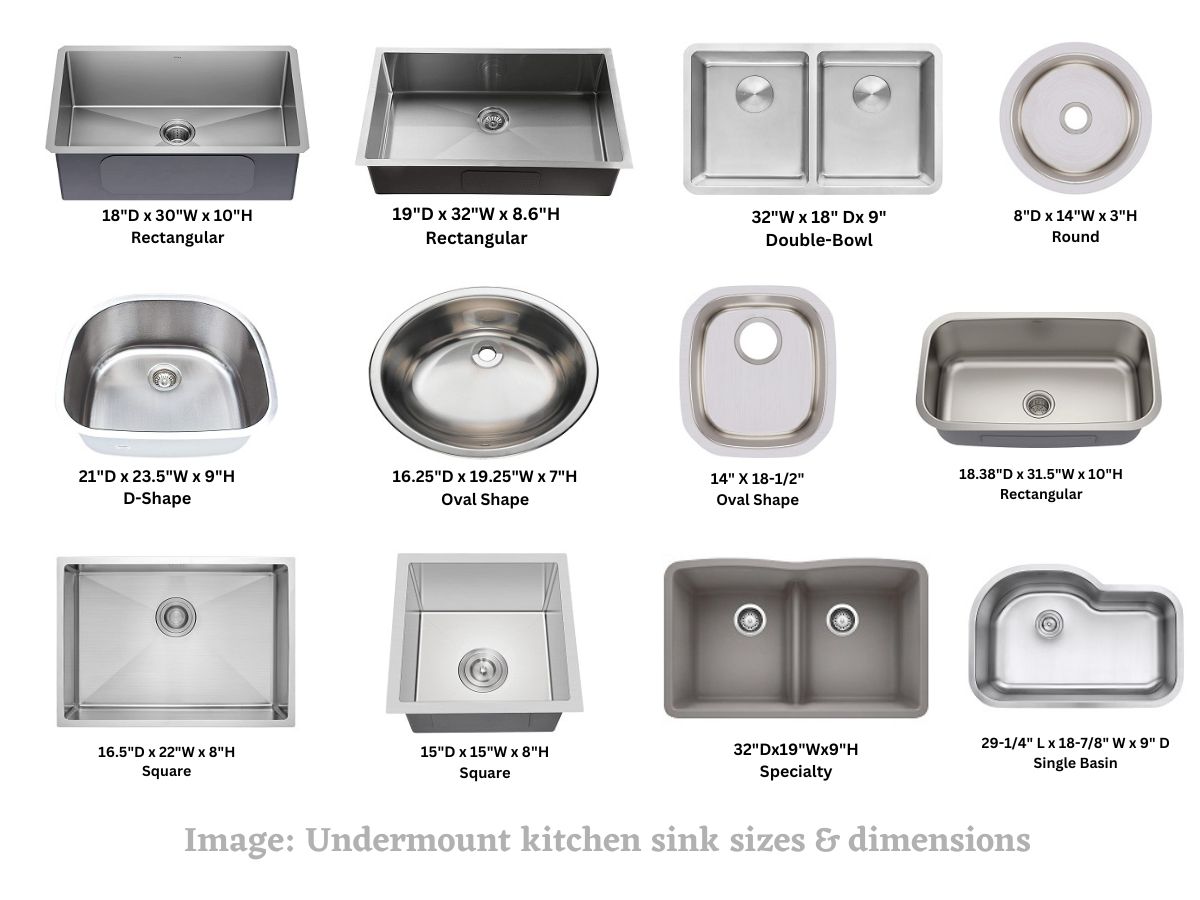
Average price of undermount kitchen sink
The price of an undermount kitchen sink varies depending on its material, size, number of bowls, additional accessories, and many other elements. However, the average cost of an undermount kitchen sink can be estimated between $170 and $2000. And this is not the limit, as the price may even reach around $3000.
Let me give you an example to show the difference in pricing. The cheapest or most reasonable materials for an undermount sink are stainless steel. If you want to purchase a double bowl stainless steel undermount sink, you may have to spend around $250-$500, whereas, the same material sink with a workstation may cost around $370-$1500.
Pros and cons of undermount sink
Undermount kitchen sink undeniably enhance the beauty of a kitchen tenfold. Whether you need a kitchen sink for a newly designed kitchen or to remodel your current one, an undermount sink can be a great option.
However, every good thing has shortcomings, and an undermount sink is no exception. Consider the following benefits and drawbacks before deciding whether an undermount sink is the best option for your kitchen.
The benefits of an undermount sink:
- Provides a bit more counter space compared to drop-in sinks
- High-quality sink
- Seamless appearance makes a kitchen look elegant and classy
- Dirt from countertops can be wiped directly into the sink
- Lack of edges makes maintenance easy
- Gives a flexible faucet placement
The problems of an undermount sink:
- Requires non-porous, water-resistant countertops such as granite, fireclay, etc.
- Gunk can accumulate on the joints of the sink and the countertop
- Heavy dishes can cause chipping off the sealings
- Sink and installation both have a high cost
- Installation and replacement require expert hands
- Precise measurement required for perfect fitting
- Heavy sinks require additional support
What to Consider when Choosing an Undermount Kitchen Sink
Knowing what essential qualities to look for in an undermount kitchen sink can help you determine your needs and expectations for the sink.
The following buying guide outlines the key characteristics you should look for when choosing an undermount kitchen sink.
ADA Compliant
The Americans with Disabilities Act (ADA) has stated standards for sinks to make their design accessible to disabled people. According to the guidelines, the highest mounting level of the sink is 34 inches off the floor. Besides, below the sink, 27×30 inches of knee clearance and 11 to 25 inches of knee depth should be provided for accessing the sink with a wheelchair.
Moreover, the faucet should be turned on with one hand, whether by touch or a push button. So, keeping in mind the struggles of disabled people, select the sink that is ADA compliant.
All-in-one kit
Sinks with all-in-one kits are convenient for installation. If you get all the accessories with the sink, you won’t have to deal with the hassle of buying them separately. Hence, consider whether the sink comes with sink bowl, faucet, disposal drain, bottom grid, screw, clips, etc.,
Compatible with Garbage Disposal
A garbage disposal is essential for processing food waste. Without the garbage disposal, food wastes may get clogged in the drain as they won’t be able to pass through the trap. Therefore, choose a sink that is compatible with a garbage disposal to guarantee a proper drainage system in the sink.
Noise insulation
Next, look for if the material of the sink has a sound insulation feature. Usually, stainless steel sinks cause noise when pots and pans are kept in or get touched by the sink. So, a better alternative to stainless steel can be graphite, fireclay, etc., materials that have noise insulation features as well as are durable similar to stainless steel.
Rust Resistance
Rust resistant kitchen sink material ensures the long life and durability of the sink. As kitchen sinks are always exposed to water for the majority of the time, they can rust easily. So it’s important to use rust-resistant kitchen sinks so they won’t degrade over time.
Watersense labeled
WaterSense, a partnership program by the U.S. Environmental Protection Agency (EPA), is a step towards nature conservation and saving water. The WaterSense labeled products ensure that the products meet the efficiency and performance criteria of the EPA as well as consume 20% less water.
So, whatever sink or faucet you choose, make sure it is WaterSense labeled so that you can contribute to making the environment sustainable from your end.
Workstation
A sink with the facilities of a workstation makes chopping and washing vegetables and other dirty items easier. While selecting an undermount kitchen sink check out if the sink has the option to place kitchen accessories such as a cutting board, colander, bottom grid, drying rack, etc.
Countertop Compatibility
Undermount kitchen sinks have limitations on the countertop materials. That is, all types of countertops are not compatible with an undermount sink. As the sink needs to be mounted underneath, solid, non-porous, waterproof countertop materials, for instance, granite, quartz, concrete, etc., can hold the sinks in place.
Fingerprint Resistance
Fingerprint stains compromise the aesthetic look of an undermount sink. The sinks that make stain resistance claims should first demonstrate resistance to fingerprints. Beside the sink, check faucets and other accessories for their resistance to fingerprints.
Top undermount kitchen sink brands to consider
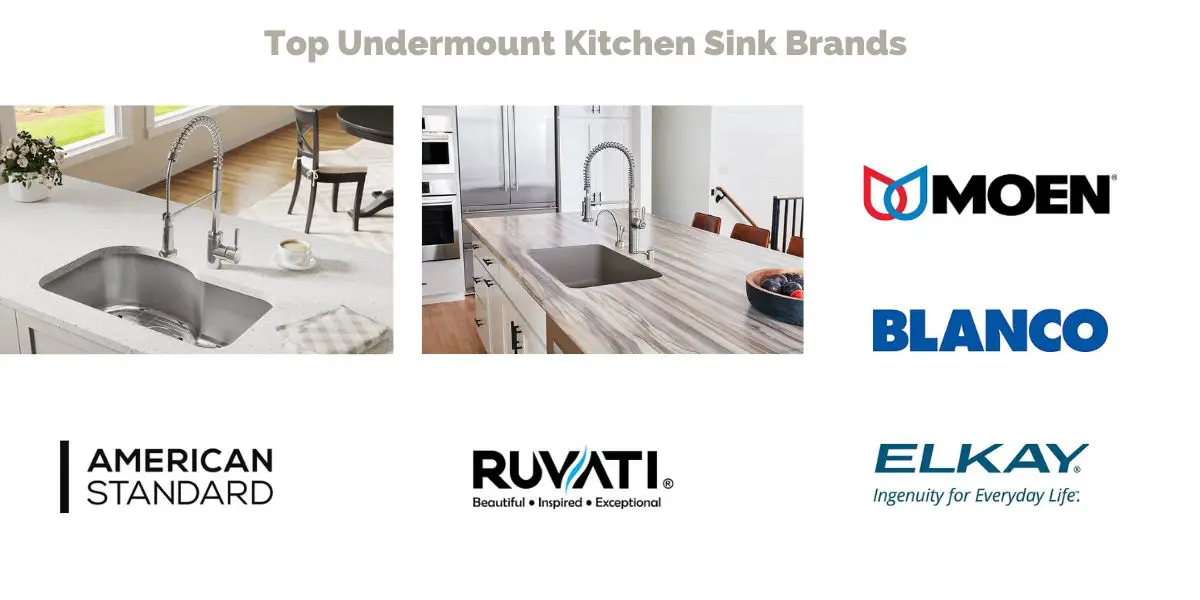
When it comes to choosing a high-quality sink, brand matters. A trustworthy brand ensures consumer satisfaction by providing the best quality sink and service. However, it doesn’t mean you have to rely on only big brands. There are numerous new and small brands, whose sinks are just as impressive as those of the top-tier brands.
Therefore, choose a branded sink over a generic one if you want to purchase the best undermount kitchen sink available. Here are some of the popular brands you can consider for purchasing an undermount kitchen sink.
Blanco undermount kitchen sink

Blanco is a trusted sink brand, providing the best quality sinks for almost a century. They have both single and double bowl sinks of different materials with the perfect combination of functionality and style.
Depending on customers’ needs, Blanco offers stainless steel, silgranit, fireclay, and other material sinks. Besides, their steel art sinks are perfect if you want a more sophisticated design.
Why should you choose Blanco?
- Durable and long-lasting material
- Heat and scratchproof sink
- Best value for money
- Have both affordable and high-range sinks
- Wide range of contemporary design
No matter how durable they are, damage is still a possibility. For this reason, all their sinks come with warranties to deal with the damaging issues.
Elkay undermount kitchen sink
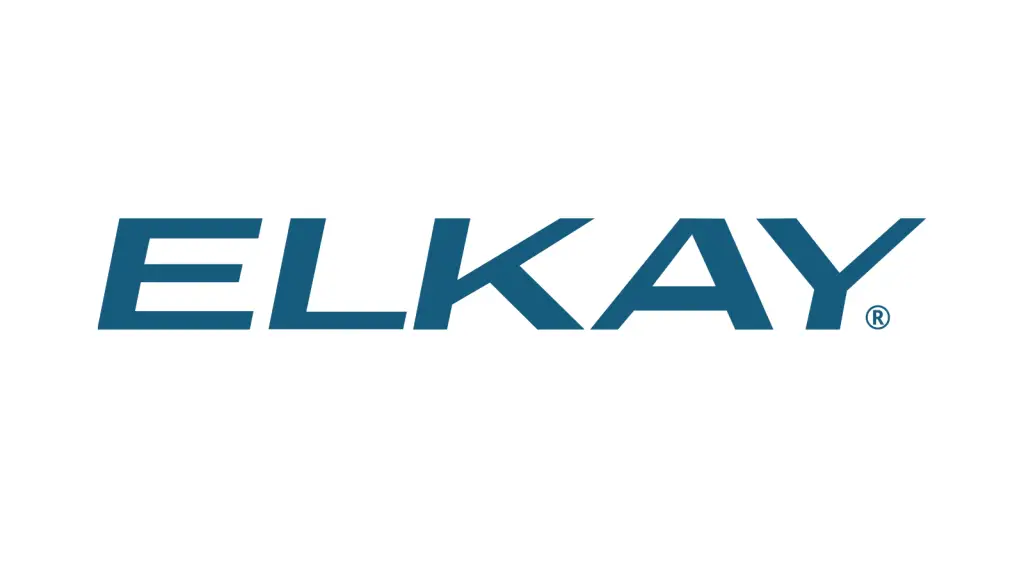
Elkay is another top brand for sinks. Their history with sink production dates back to 1920. They have been offering top-notch sinks for all these years, which has secured them the top spots in the sink market.
They have sinks made of a wide range of materials, for instance, ceramic, quartz, copper, fireclay, and more. However, in America, their best-selling item is stainless steel sinks.
Why should you choose Elkay?
- High-quality sinks
- Lifetime warranty
- Best for stainless steel sink
- Available at most major retailers
American Standard undermount kitchen sink

One of the most reputable manufacturers of sinks for both residential and commercial use is American Standard. Since 1875, they have been producing high-quality sinks for every kind of kitchen. They offer stainless steel, cast iron, and fireclay for residential sinks. Although warranties differ for each material, stainless steel comes with a lifetime warranty.
Why should you choose American Standard?
- Reliable company
- Lifetime warranty for stainless steel sinks
- Simple design for residential and commercial applications
- Available at most retailers
Moen undermount kitchen sink

Moen is one of the top faucet brands in North America. Along with faucets, they offer high-quality stainless steel, granite, and copper kitchen sinks. Their sinks and faucets are suitable for commercial and residential applications. Whether you need a single or double bowl sink, you will get the best quality sinks.
Why should you choose Moen?
- Lifetime limited warranty
- Trusted and durable sinks
- Contemporary design
Ruvati undermount kitchen sink

Ruvati started its sink manufacturing journey in 2009. Although it’s a new company compared to the others, it offers high-quality functional sinks. They have very selected materials for sinks, which are stainless steel, fireclay, and granite. However, their two-tier workstation design is ideal for a complete food preparation station.
Why should you choose Ruvati?
- Useful contemporary design
- Products come with warranty
- Available at both smaller and larger retailers
How to install undermount sink
An undermount sink installation requires extremely precise fabrication, which professional fabricators can deal with without any issue. However, if you are confident in your sink mounting skills, you can try installing it on your own. Although it may sound pretty much difficult, it’s easy if you maintain precise measurements.
Follow these steps to install an undermount sink.
Step 1: Cut a hole in the countertop
- The first step is to cut a hole in the countertop. For that, if your undermount sink comes with a template you can use that, or you can flip the sink over the countertop to trace the sink.
- After you have traced the sink in the position you want to place your sink, start cutting the hole 1/2 inch smaller than the traced lines.
Step 2: Apply adhesive
- For adhesive, you can use either silicon sealant or two-part epoxy.
- As the sink will be installed from underneath the countertop, you have to apply the adhesive on the underside edges of the countertop and place the sink maintaining the alignment.
- You can use brackets and screws or clips to provide additional support to the sink. However, you can also use clamps for the duration till the adhesive dries.
- If epoxy or silicone caulk squishes out of the sink make sure to wipe them off, or else when dried they will be hard to remove.
Step 3: Drying
- Leave the adhesive to dry according to the manufacturer’s instructed time. Usually, it takes at least 24 hours.
Step 4: Plumbing
- After the adhesives have completely cured, it’s time for the final step which is attaching the sink accessories, such as the disposal drain.
- Connect the sink basin, and garbage disposal properly to the main drain tailpiece and ensure the drainage system has been properly set.
Note:
You can easily flip the countertop and set the sink if you install the sink in the kitchen before assembling the countertop.
If the sink is heavy, you can attach additional sink support from the base of the cabinet.
Who to call to fix undermount sink
Fixing an undermount sink is not a task that anyone can do. If you need to fix your undermount sink, you should look for a nearby plumber or undermount sink repair service. However, it’s essential that they be experts and have knowledge of working with your countertop material. Therefore, be sure to verify their credentials and license before hiring them.
At this point, you might be wondering why fixing an undermount sink calls for a professional. Let’s find the answers.
- They have greater knowledge about the countertop materials
- They have access to professional tools
- They can remove the sink without damaging the countertop
- They can fix and re-install the sink professionally
Note:
It’s best to avoid hiring a generic plumber to fix the sink because your warranty might not cover installation and mishandling damage
Cost to install undermount sink: How much does it cost to install an undermount sink
Undermount sink installation requires precise measurements and professional fabrication. Undermount sinks come in a variety of styles, some of which can be installed with only moderate precision while others require high precision.
Besides, there are other factors that influence the installation price, for instance, the size and weight of the sink, your geographical location, style of mounting, workload, etc.
According to Thumbtack, replacing the undermount kitchen sink where the plumbing already exists may cost around $230. However, for renovating the kitchen, the price can get doubled. So depending on the material, installation style, and other factors, the price may range between $350 and $1500.
If you have a smaller kitchen and want to install a corner undermount, then the installation may cost around $480 to $1350.
What adhesive is used for undermount sink
Undermount sinks have a variety of adhesive options, among which epoxy and silicone are notable. Given that kitchen sinks have frequent contact with water, the adhesives used for sealing the joints between the sink and the countertop should be 100% water-resistant.
On that note, some use two-part epoxy and others use 100% silicone sealant. If you compare silicone with normal two-part epoxy, silicone has a high heat resistance of up to 200 °C, whereas epoxy can withstand up to 120 °C.
No matter whether silicon or epoxy is used for adhesive, both are excellent at holding the sink in place. However, if you want to make your sink extra secure, you can attach brackets and clips for additional support.
Which Undermount Kitchen Sink is Right for You?
Making the best product choice is a personal decision. An undermount kitchen sink that is perfect for one person may not be the right one for you. So, to identify your right undermount kitchen sink, have a clear idea about the following.
Workload: First you have to identify the workload of your kitchen counter. If your sink has to deal with lots of heavy pots and pans, then you would have to choose a sink that can withstand the heavy workload.
However, if you have less workload and do the dishes in the dishwasher, you can go with a fancy one that will work to enhance the beauty of your countertop and kitchen.
Material: Your choice of material also plays a role in deciding the sink. As the undermount kitchen sink comes in various materials such as granite, fireclay, stainless steel, copper, etc., you should decide which one you would like to see in your kitchen.
Number of basins: There are single, double, and even triple, sink bowl options for undermount kitchen sinks. Depending on your counter space, you have to decide how many sink bowls can fit into your countertop. If you have a large kitchen, then going with a double or triple countertop will make your work easier.
Budget: Last but not least is your budget. Depending on the material and number of sinks, the price varies. If you have a reasonable budget and want a long-lasting sink, then stainless steel or porcelain can be a good option. However, if budget is not an issue, you can go for expensive ones like granite, copper, etc.
Most Asked Questions of Undermount Kitchen Sink
What is the cabinet under the sink called?
The cabinet under the sink is called a base cabinet or vanity. Usually, the undermount sink is placed inside this cabinet to support the countertop and sink as well as give the kitchen a clean look.
What is the best type of undermount sink?
The best type of undermount sink depends on your preference. If you want to give your kitchen a clean look, a neutral reveal or a negative reveal can be a great option. However, if you wish to use accessories such as a chopping board or drying rack then a positive reveal can be your best type of undermount sink.
Which sink is better undermount sink or top mount?
The undermount and top mount sinks each has their own appeals. If you want to give your kitchen a seamless look then an undermount sink would be definitely better than a top mount. However, if your target is to install a cost-effective sink, then a top mount would seem better to you.
Which is the best sink for kitchen?
The best sink for kitchen depends on your preference, kitchen space, budget, the purpose of use, and more. To find the best sink for your kitchen, you have to first have a clear understanding of your needs and the capacity of your countertop. Then you can decide whether an overmount, undermount, or farmhouse sink is the ideal sink for your kitchen.
Are undermount sinks harder to clean?
No, an undermount sink is not hard to clean; rather, it is easier than most other sinks. As the rims of the sink stay under the countertop, there are no cracks and crevices for the dirt and grime to get trapped. Also, the sinks have garbage disposals, which clean off food scraps without clogging the drain pipe.
Which sinks are installed above the countertop?
The sinks that are installed above the countertop pre-cut hole are known as top-mount sinks. As they are installed over the countertop, resting on the rims of the countertop, they are also called overmount sinks.
Can you have an undermount sink with laminate countertops?
In the past, the quality of the laminate countertops was not compatible for use with undermount sinks. However, with time, the quality of the laminate countertops has been upgraded and provided with better water resistance. As a result, they are now compatible for use with undermount sinks. You can easily find some amazing undermount sinks for laminate countertops in the market.
Can you replace an undermount sink without damaging the granite?
Yes, if an expert in installing granite undermount sinks performs the replacement. They can safely detach the sink from the countertop by cutting off the glue without damaging the granite.
Can you undermount a sink with butcher block?
Although you can undermount a sink with a butcher block, it is not recommended. Since the cut edges of the countertop will come into contact with water regularly, the wood has a high chance of getting damaged.
Where to buy undermount kitchen sink?
Undermount kitchen sinks are available in both online and physical shops. If you have time to visit a shop, then you can make a purchase there. However, if you don’t have time or don’t want the hassle of visiting shops, you can buy from Ecommerce platforms like Amazon, Walmart, Home Depot, etc.
Conclusion
Now that we have reached the end of our discussion, hope the article has helped you learn details about undermount kitchen sinks.
If you are thinking of remodeling your kitchen, then you can certainly try out the undermount kitchen sinks. However, make sure you choose fabricators who are experts at working with the countertop and sink materials you will be installing.

